Stanford Scholars Study Computer to See Homosexuality: Up to 91% Accuracy
澎湃 News Reporter Han Hanqi Wang Xinxin
Stanford University’s Michal Kosinski and Wang Xiaolun discovered that computer-identified homosexual men have a high accuracy rate of 91%, and homosexual women, through features extracted from over 30,000 faces. 83%. The paper argues that, consistent with the prenatal hormone theory, homosexual men are more "female" in appearance, have a narrower chin, have longer noses, and have more foreheads, whereas homosexual women have the opposite.
This paper, entitled "Deep Neural Networks Based on Face Image to Determine Sexual Orientation More Accurate Than Humans," was published on the September 7 issue of the Journal of Personality and Social Psychology. Hot media and social networking.
The British "Guardian" fears that this technology will lead teenagers to "self-test" and husband and wife "measure each other." In countries where death penalty for gays and lesbians is used, the technology is more likely to become a killing tool.
However, in the author's opinion, their research is a warning against face recognition technology and Internet privacy issues, and is a demonstration of the possible future misuse of technology. In the article, the author called for the government and enterprises to formulate relevant laws and regulations, develop related technologies, and reduce the privacy risks of gay groups.
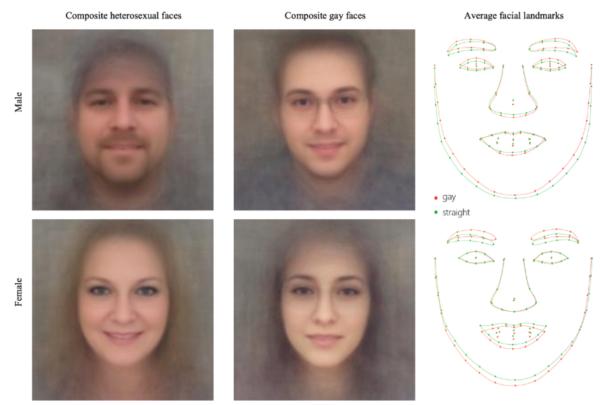
Heterosexual (left), gay (middle) male and female composite facial images, rightmost heterosexual (green), homosexual (red) male and female average facial markings
The abstract of the paper writes: “We found that people's face contains more information on sexual orientation than the human brain can perceive. We use deep neural networks to extract features from 35,326 facial images. We enter these features into logistic regression. The algorithm categorizes sexual orientation: given a single facial image, the classifier can discriminate homosexual and heterosexual males with a probability of 81%, while women have 71%. The human judgment rate is much lower: 61% for males. For women, 54%, given the same person's five facial images, the accuracy of the algorithm can be increased to 91% and 83%, respectively.The facial features used by the classifier are fixed features such as the shape of the nose, and there are also temporary features such as dress style. Men and women tend to have atypical facial features, facial expressions, and styles of dress, which is consistent with the theory that prenatal hormone exposure affects sexual orientation, while the sex classification model detects homosexual men with an accuracy rate of 57%. The rate is 58%.These findings increase our understanding of the origin of sexual orientation and human cognitive deficits.Moreover, there is a growing number of companies and governments. Use the intrinsic characteristics of the probe's computer vision algorithms, our research has shown that privacy and security are threatened by homosexuality. "
Algorithm accuracy: 91% male, 83% female
The researchers obtained public data from the American dating site, including 130,741 photos of 36,630 men and 170,360 photos of 38,593 women, aged between 18 and 40. Their sexual orientation is informed through the intention of their partner's gender.
Subsequently, the researchers processed the faces in these photos with Face++ software and removed some photos. Then, they manually screened whether the photographs were adult whites, and whether gender and network data were consistent. Finally, they immediately removed some photos to balance the number of heterosexuals and homosexuals. The sample left included 3947 homosexual and heterosexual men and 3,441 homosexual and heterosexual women.
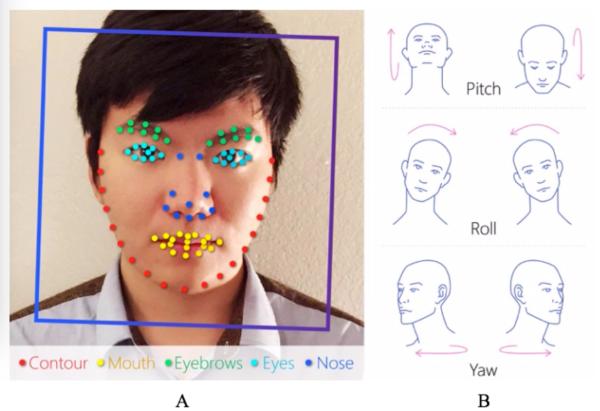
Handle public photos from dating sites in the U.S.
The researchers used a deep neural network called VGG-Face to extract the features of the images and use them to train logistic regression models. Experimental results show that, given a single facial image, the classifier can discriminate homosexual and heterosexual men with a probability of 81%, while women have 71%. Given five facial images of the same person, the accuracy of the algorithm can be increased to 91% and 83%, respectively.
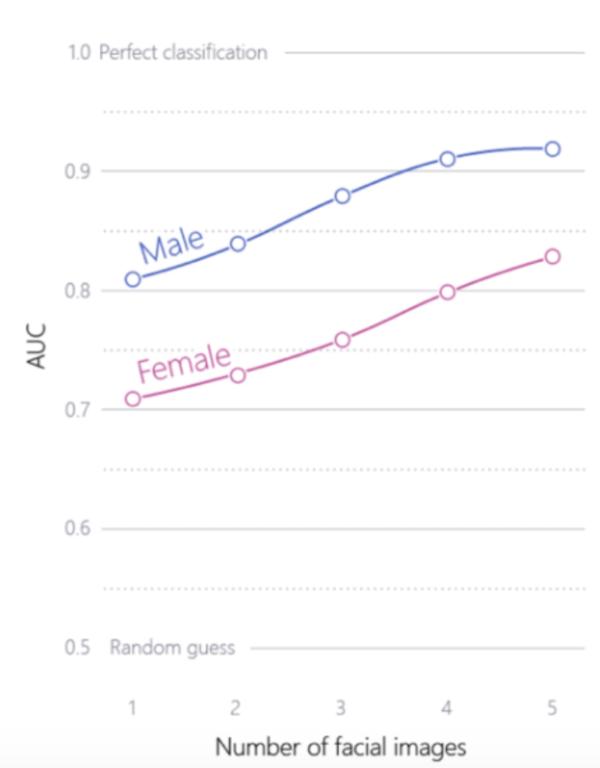
Given 1 to 5 photos of individual men (blue) and women (red), the accuracy of the algorithm is improved.
In line with prenatal hormone theory: Gay men are more "feminized"?
In the introductory part, the authors stated that an important reason they chose to study sexual orientation was "the widely accepted sexual orientation of prenatal hormone theory (PHT), which predicts the relationship between appearance and sexual orientation."
The paper writes that according to the theory of prenatal hormones, male embryos are too little exposed to androgens, or female embryos are exposed to male hormones too much, which may cause sexual orientation to be alienated. However, androgens are also associated with sexual facial differentiation. The prenatal hormone theory predicts that homosexuals tend to have atypical facial features. That is, homosexual male faces should be more feminine, and homosexual female faces should be more masculine.
Researchers' collection of sites identified by classifiers has become what the computer considers to be "most homosexual" and "much less homosexual". The dissertation holds that the computer recognition results are consistent with the prenatal hormone theory, and homosexuality looks more atypical than gender. On average, homosexual men have narrower chins, longer noses and larger foreheads, while homosexual women have the opposite.
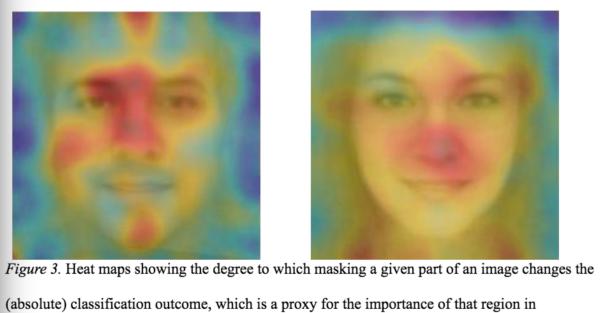
The more red the area, the more important in the algorithm
To further test the hypothesis that "sexual homosexuals are less gender-typical", the researchers also tried to discriminate between homosexuality and heterosexuality through a 98% accurate gender classifier and found that the accuracy rate in males was 57%. The accuracy rate on the body is 58%. The paper writes: "The data shows that the feminization of male faces is positively correlated with homosexuality, while that of females is the opposite."
Several limitations of the study
However, in the discussion section of the paper, the author emphasizes that the conclusion of the study should not be misread by readers. First of all, homosexuality does not even have gender stereotypes. It does not mean that all homosexual men are feminine and that all homosexual women are not feminine.
Second, 91% of the values ​​in this experiment should not be misread. In the United States where the percentage of homosexuals is approximately 6% to 7%, classifiers need to sacrifice substantial accuracy to cover a large number of samples.
The paper also pointed out several limitations of the study: the sample was limited to white people, did not exclude bisexuality, and people who could not rule out the appearance of “more homosexual†were more likely to “go out of the boxâ€.
The author has also thrown several other interesting questions, such as gay men less beard, mainly physiological (less hair) or taste reasons? Does the classifier identify men more accurately than women, does it mean that women's sexual orientation is more fluid?
See the face of criminals, knowledge of rich and poor, knowledge of homosexuality: science to face surgery?
In recent years, computer vision recognition technology has developed rapidly. From the handling of identity documents, electronic payments to airport security, office access, face recognition technology is entering the daily life of people. However, some researchers tried to identify the relationship between appearance characteristics and intrinsic character through computer vision recognition, which triggered widespread controversy.
In November last year, Prof. Wu Yulin of Shanghai Jiaotong University pointed out in his article “Inferring the Probability of Automatic Crimes Based on Facial Images.†It was pointed out that the machine can distinguish who is a criminal and who is a law-abiding citizen through photographs, and the recognition rate is over 86%. Afterwards, a study by the University of Toronto at a machine to see the rich and poor has also caused some controversy.
Earlier, an Israeli start-up company claimed that the face recognition program it developed had successfully identified nine terrorists who participated in the terrorist attacks in Paris in November 2015. It also recognized pedophiles and white-collar criminals.
Although these studies have been ethically controversial, from the point of view of the paper, Cosinski and Wang Haolun obviously do not agree that the study in this area is completely placed under the exclusion zone.
In the introductory part, the paper mentions that the face-to-face technique can be traced back to ancient China and ancient Greece, and Pythagoras had a “looking face†student. In the early 19th century, the Italian surgeon, Lombrosuo Bros., pioneered the “criminal theory of natural crimes†and pointed out that criminals can be identified by facial features.
"Now, face-to-face surgery is widely recognized as a pseudoscience that blends superstition with racism. Due to the question of legitimacy, research, and even the discussion of the connection between facial features and personality, has become taboo. The link does not exist. A general premise. However, many mechanisms suggest that the situation is the opposite."
"What is important is that the low accuracy of human judgment on face judgment does not necessarily indicate that clues are not clearly placed there. However, humans may lack the ability to detect or interpret... Therefore, we test this with modern computer vision algorithms. Assumptions."
Gay groups are dangerous!
The authors of the paper tried to warn us through this study that public data on social platforms can be used to make targeted classifiers. The article wrote: “Predictive sexual orientation may pose a serious threat to homosexual men and women and society as a whole, and even life threats.... Many countries’ laws recognize that homosexuality is a crime and 8 countries will impose homosexuality on death penalty. Therefore, we let policy makers Technology companies and gay and lesbian groups know how high the accuracy of face recognition can be. This is critical."
Although the papers demonstrate precisely what the paper objected to, the authors emphasize that they are not trying to create an intrusive tool, but rather to demonstrate some commonly used intrusion paths. Right now, some governments and companies are studying the connection between face recognition and intrinsic personality, and risk warning is imminent. The author hopes that their research will remind the government and companies to formulate relevant laws and regulations, develop related technologies, and reduce the privacy risks of gay groups.
Social networking site information shows that Kosinski is an assistant professor at Stanford Business School and a Ph.D. in psychology from Cambridge University in 2014. He has worked at Microsoft Research and Cambridge University and has spoken about privacy issues on public issues. He graduated from Zhejiang University with a bachelor's degree in Stanford in 2016. He is currently an IDG Capital investment adviser in the San Francisco Bay Area, focusing on AI, robotics, machine learning, and computer vision.
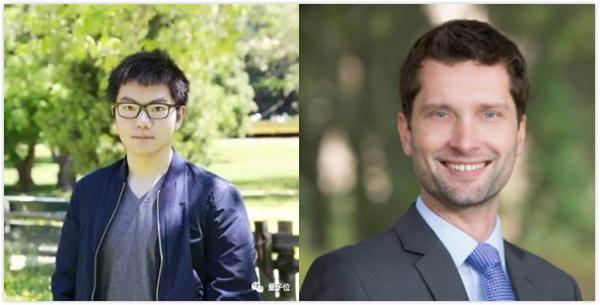
Wang Lunlun (left) and Kosinski (right)
Test items
The performance indicators are tested using a dedicated Ethernet test instrument, and the test results of these performance indicators can also evaluate whether the LAN system meets the acceptance requirements. From GBT21671-2008 "Ethernet-based LAN System Acceptance Evaluation Specification", it can be understood that LAN can also judge performance by measuring performance indicators such as network throughput, transmission delay, and packet loss rate. The Ethernet tester is a rugged test platform suitable for field use. It has a complete Ethernet test function, dual optical ports and dual electrical ports, Ethernet service interface module, HST-3000 supports multiple data stream tests. Including 10/100/1000M Ethernet link traffic generation and troubleshooting, it can test electrical and optical port links up to 1Gbit/s. Due to the limitation of various conditions in the acceptance inspection, point-to-point or routing network testing can be supported for routine testing of switches.
The problem
The overall characteristics of modern test instruments are high reliability, high performance and high applicability. Therefore, the gap between domestic test products and foreign products is reflected in this aspect. Although some domestic testing equipment is close to the international advanced level in certain performance indicators, there are generally few products with comprehensive equipment performance indicators that meet international standards. In addition, most of the domestic test instruments are common specifications, which cannot meet the test work in some special environments. Low-level automated testing is also a common problem. [3]
Switch test technology
Nowadays, switches put forward new requirements on the performance of switches based on application requirements. There have been new developments in comprehensive network services, security, and intelligence. Protocol testing is a basic switch testing technology. The network protocol is to improve the efficiency of testing and the effectiveness of communication to ensure the rules of communication. In the era of increasing network communication, network protocols are also indispensable. The basic requirements of network protocols are correct functions, good interoperability and superior performance. The initial prototype of protocol testing is software testing, and the main categories are black box testing, white box testing and gray box testing.
Ethernet Switch,Web Management Switch,Non-Web Management Switch,Reverse Power Switch,10G Switch,Combo Port
Shenzhen GL-COM Technology CO.,LTD. , https://www.szglcom.com